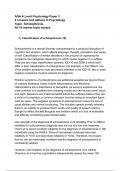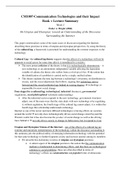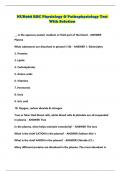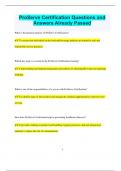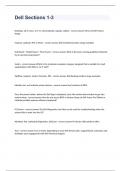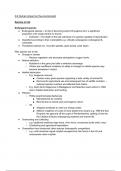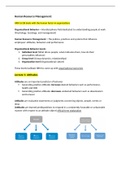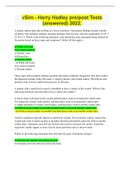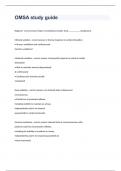4.3 Issues and options in Psychology
Topic: Schizophrenia
All 16 marker topic essays
1) Classification of schizophrenia (16)
Schizophrenia is a mental disorder characterised by a profound disruption of
cognition and emotion, which affects language, thought, perception and sense
of self. Classification of mental disorders is the process of organising the
symptoms into categories depending on which cluster together in a sufferer.
They are two major classification systems; ICD-10 and DSM-5 which both
differ in their classification of schizophrenia. For example, in the DSM-5, one
of the positive symptoms must be present whereas in the ICD-10, two or more
negative symptoms must be present for diagnosis.
Positive symptoms of schizophrenia are additional experiences beyond those
of ordinary existence; these include hallucinations and delusions.
Hallucinations are a disturbance in perception via sensory experiences, the
most common is in auditory form (hearing voices) but can include smell, touch
and sight. Delusions are irrational beliefs where the sufferers believe they are
a victim of conspiracy; a common delusion involves being an important figure
such as Jesus. The negative symptoms of schizophrenia involve the loss of
usual abilities and normal functioning. This includes speech poverty whereby
there is an inability to produce fluent words and quality of speech which is
thought to reflect blocked thoughts and avolition which is a loss of motivation
and difficulty completing goal-oriented tasks.
One strength of the diagnosis of schizophrenia is its reliability. Prior to DSM-5,
reliability for schizophrenia diagnosis was low but this has now improved.
Osorio et al report excellent reliability for the diagnosis of schizophrenia in 180
individuals using the DSM-5. Pairs of interviewers achieved inter-rater
reliability of +0.97 and test-retest reliability of +0.92. Therefore, this means
that we can be reasonably confident that the diagnosis of schizophrenia is
consistently applied.
However, one limitation of the diagnosis of schizophrenia is its validity.
Cheniaux et al had two psychiatrics independently assess the same 100
,clients using ICD-10 and DSM-5 criteria and found that 68 were diagnosed
with schizophrenia under the ICD system and 39 under DSM. This suggests
that schizophrenia is either over or underdiagnosed according to the
diagnostic system, either way this suggests that criterion validity is low.
However, in Osorio’s study, there was excellent agreement between clinicians
when they used two measures to diagnose schizophrenia both derived from
the DSM system. This means that the criterion validity for diagnosing
schizophrenia is actually good provided it takes place within a single
diagnostic system.
A further limitation of schizophrenia diagnosis is the existence of gender bias.
Since the 1980s, men have been diagnosed with schizophrenia more
commonly than women, Fisher and Buchanan have identified a 1.4:1 ratio.
One possible explanation for this is that women are less vulnerable than men,
perhaps because of genetic factors, however it seems more likely that women
are underdiagnosed because they have closer relationships and hence get
support. This leads to women with schizophrenia often functioning better than
men. Therefore, this underdiagnosis is a gender-bias and means that women
may not therefore be receiving treatment and services that might benefit them.
Another limitation challenging the reliability of diagnosing schizophrenia is the
culture bias. For example, African Americans are far more likely to be
diagnosed with SZ compared to patients belonging to Western cultures, due to
their increased openness about admitting to certain SZ symptoms which may
appear normal in their respective cultures. For example, the phenomenon of
hearing voices may be considered a desirable sign of increased spirituality
and connectedness with ancestors, and so may even be encouraged.
However, both classification systems would view this as a hallmark
characteristic of SZ and, combined with the potential distrust in African
Americans that white psychiatrists may have, could increase the likelihood of
false diagnoses.
, 2) Biological explanations for schizophrenia (16)
One biological explanation for schizophrenia is the genetic basis, such as
family studies, candidate genes and the role of mutation. Family studies have
confirmed that the risk of schizophrenia increases in line with genetic similarity
to a relative with the disorder. This relationship is shown in Gottesman’s
large-scale family study. For example, someone with an aunt with
schizophrenia has a 2% chance of developing it, this increases to 9% if the
individual is a sibling and 48% if they are an identical twin. In terms of
candidate genes, it appears that a number of different genes are involved in
the onset of schizophrenia, suggesting it’s polygenic. Ripke et al combined all
previous data from genome-wide studies of schizophrenia. The genetic
make-up of 37,000 people with a diagnosis of schizophrenia was compared to
that of 113,000 controls, 108 separate genetic variations were associated with
slightly increased risk of schizophrenia. As different studies have identified
different candidate genes, it also appears that schizophrenia is aetiologically
heterogeneous, different combinations of factors can lead to the condition. In
terms of the role of mutation, schizophrenia can also have a genetic origin in
the absence of a family history of the disorder. One explanation for this is the
mutation in parental DNA which can be caused by radiation, poison or viral
infection. Evidence for mutation comes from positive correlations between
paternal age and risk of schizophrenia, increasing from around 0.7% with
fathers under 25 to over 2% in fathers over 50, which Brown et al found.
One strength of the genetic explanation for schizophrenia is the strong
evidence base. Family studies such as Gottesman show that risk increases
with genetic similarity to a family member with schizophrenia. Adoption studies
such as Tienari et al, show that biological children of parents with
schizophrenia are at heightened risk even if they grow up in an adoptive
family. Therefore, this suggests that some people are more vulnerable to
schizophrenia as a result of their genetic make-up. A recent twin study by
Hilker et al provides further support for this, as they show a concordance rate
of 33% for identical twins and 7% for non-identical twins, showing that as
genetic similarity increases, so does the rate of schizophrenia.
However, one limitation of the genetic explanation is there is clear evidence to
show that environmental factors also increase the risk of developing
schizophrenia. These factors include both biological and psychological
influences. Biological risk factors include birth complications, as identified by

